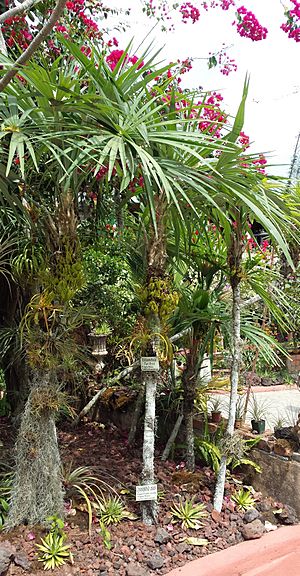Cryosophila nana facts for kids
Quick facts for kids Cryosophila nana |
|
|---|---|
 |
|
| Crysophila nana at the Vallarta Botanical Gardens with Tillandsias growing along the trunks | |
| Conservation status | |
| Scientific classification | |
| Genus: |
Cryosophila
|
| Species: |
nana
|
The Cryosophila nana is a special type of palm tree found only in Mexico. It is also known as the "dwarf palm" because nana means "dwarf" in Latin. This unique plant is a flowering plant and belongs to the Arecaceae family, which is the big family of all palms. Sadly, this palm is facing threats, mainly from habitat loss, which means its natural home is disappearing.
Contents
What is Cryosophila nana?
The Cryosophila nana is a small to medium-sized palm tree. It has a slender trunk and large, fan-shaped leaves. These leaves are a beautiful green color and can be quite wide. The palm also produces small flowers and then fruits, which are important for its reproduction.
Where Does This Palm Grow?
This special palm is found only in Mexico. It grows in specific areas, often in forests or along riverbanks. It likes warm, humid places, which are common in parts of Mexico. Its natural home includes areas in both Northwestern and Southwestern Mexico.
Why is it Special?
Cryosophila nana is part of the amazing plant life that makes Mexico so diverse. It plays a role in its ecosystem, providing habitat or food for other creatures. Each unique species, like this palm, helps keep the natural world balanced and healthy.
Why is Cryosophila nana in Danger?
The biggest threat to Cryosophila nana is habitat loss. This happens when forests are cut down for farming, building, or other human activities. When its home disappears, the palm has fewer places to grow and reproduce. This makes it harder for the species to survive.
Conservation Status
The Cryosophila nana is listed as "Near Threatened" by the International Union for Conservation of Nature (IUCN). This means it's not yet critically endangered, but it's close to becoming so. If we don't protect its habitat, it could face a much higher risk of disappearing in the future.
Protecting the Cryosophila nana
Protecting this palm means protecting its habitat. This can involve setting up protected areas where plants and animals are safe. It also means educating people about the importance of biodiversity and how human actions can affect nature. By working together, we can help ensure that unique species like the Cryosophila nana continue to thrive for many years to come.
See also
 In Spanish: Palmillo de México para niños
In Spanish: Palmillo de México para niños


